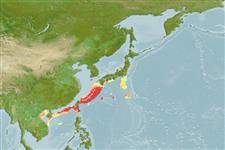>
Alepocephaliformes (Slickheads and tubeshoulders.) >
Alepocephalidae (Slickheads)
Etymology: Talismania: Persian, tilism and taken after Greek, telesma, teleo = to make a sacrifice, and after, talisman.
Environment: milieu / climate zone / depth range / distribution range
Écologie
marin benthopélagique; profondeur ? - 1000 m (Ref. 58018). Subtropical
Northwest Pacific: known only from the Ryukyu Trough.
Taille / Poids / Âge
Maturity: Lm ? range ? - ? cm
Max length : 27.0 cm SL mâle / non sexé; (Ref. 559)
Description synthétique
Clés d'identification | Morphologie | Morphométrie
Épines dorsales (Total) : 0; Rayons mous dorsaux (Total) : 21 - 24; Épines anales: 0; Rayons mous anaux: 21 - 23. Closely resembles T. filamentosa but differs in having a wider interorbital space (more than 75% of snout) and fewer vertebrae (less than 50). Reaches 27 cm SL.
Life cycle and mating behavior
Maturité | Reproduction | Frai | Œufs | Fécondité | Larves
Masuda, H., K. Amaoka, C. Araga, T. Uyeno and T. Yoshino, 1984. The fishes of the Japanese Archipelago. Vol. 1. Tokai University Press, Tokyo, Japan. 437 p. (text). (Ref. 559)
Statut dans la liste rouge de l'IUCN (Ref. 130435: Version 2024-2)
Menace pour l'homme
Harmless
Utilisations par l'homme
Outils
Articles particuliers
Télécharger en XML
Sources Internet
Estimates based on models
Preferred temperature (Ref.
123201): 8.4 - 15.6, mean 10.4 °C (based on 51 cells).
Phylogenetic diversity index (Ref.
82804): PD
50 = 0.5005 [Uniqueness, from 0.5 = low to 2.0 = high].
Bayesian length-weight: a=0.00347 (0.00163 - 0.00737), b=3.19 (3.00 - 3.38), in cm total length, based on LWR estimates for this (Sub)family-body shape (Ref.
93245).
Niveau trophique (Ref.
69278): 3.5 ±0.5 se; based on size and trophs of closest relatives
Résilience (Ref.
120179): Milieu, temps minimum de doublement de population : 1,4 à 4,4 années (Preliminary K or Fecundity.).
Fishing Vulnerability (Ref.
59153): Low vulnerability (23 of 100).
